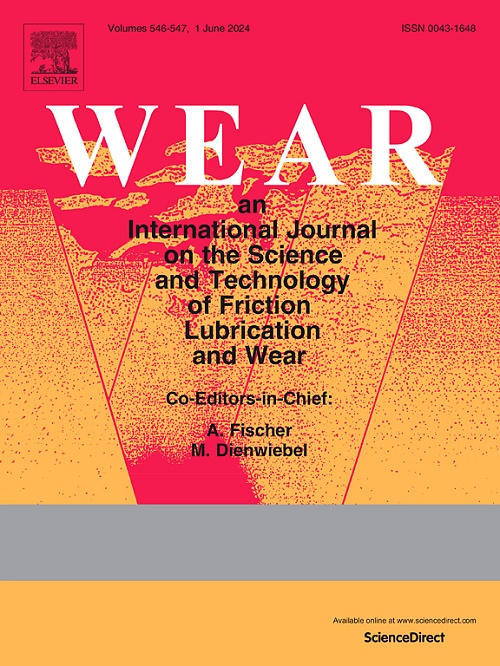电弧增材制造Ti6Al4V合金及其综合可加工性分析
IF 5.3
1区 工程技术
Q1 ENGINEERING, MECHANICAL
引用次数: 0
摘要
Ti6Al4V合金具有强度高、密度低、耐腐蚀性能好等优点,具有广阔的工业应用前景。在本研究中,在第一阶段,Ti6Al4V合金是利用直接能量沉积技术,即WAAM-CMT,在控制氩气(约。99.9%)的环境,目的是避免氧化。经热处理的Ti6Al4V合金的极限强度、延伸率、韧性和显微硬度分别比变形后的合金高9.4、19.14、122.85和16.87%。这意味着在氩气环境下WAAM-CMT工艺参数的合理选择和适当的保护。此外,为了评估其可加工性,在LCO2环境下,使用TiAlN涂层硬质合金麻花钻头对传统和WAAM-CMT开发的Ti6Al4V合金进行了钻削试验。对刀具磨损、功耗、切削力和扭矩等钻井性能参数进行了评估。侧面磨损、推力和表面粗糙度分别为94.17%、18.4%和94.2%。由于WAAMed合金具有较好的机械性能,因此与变形合金相比,WAAMed合金的力学性能更高。由于改进的机械性能,如WAAMed合金的硬度更高,钻孔工具变得更钝,孔内表面变得更粗糙,表面粗糙度比锻造合金更高。此外,功率消耗和扭矩似乎与侧面磨损无关,两种变体都有类似的轻微变化。变形合金的孔表面更光滑,这可能与表面粗糙度最小有关。在WAAMed合金的钻孔过程中形成了较小的切屑,然而,两种变体的卷曲形状等宏观方面似乎是相似的。综上所述,建议在可控氩气环境下,采用WAAM-CMT技术制备Ti6Al4V器件。本文章由计算机程序翻译,如有差异,请以英文原文为准。
Fabrication of Ti6Al4V alloy by wire arc additive manufacturing process and comprehensive machinability analysis
Ti6Al4V alloy promises to have vide industrial applications owing to high strength, low density, and better resistance to corrosion. In the present study, in the first phase, Ti6Al4V alloy was fabricated by utilizing direct energy deposition techniques namely WAAM-CMT under controlled argon (approx. 99.9 %) environment with an aim to avoid oxidation. The WAAMed Ti6Al4V alloy showed 9.4, 19.14, 122.85, and 16.87 % higher ultimate strength, elongation, toughness, and microhardness, respectively as compared to wrought variant. This implies the suitable selection of WAAM-CMT process parameters along with proper protection under argon environment. Further, to evaluate its machinability, both the conventional and WAAM-CMT developed Ti6Al4V alloys have been subjected to drilling using TiAlN coated carbide twist drill bit under LCO2 environment. The drilling performance parameters like tool wear, power consumption, cutting force, and torque have been assessed. Flank wear, thrust force, and surface roughness were found to be 94.17, 18.4, and 94.2 %. higher in the case of WAAMed alloy as compared to wrought alloy, respectively owing to its better mechanical properties as mentioned above. Due to improved mechanical properties like higher hardness for WAAMed alloy, the drilling tool gets blunt faster and the surface inside the hole becomes rougher with higher surface roughness as compared to the wrought alloy. Further, power consumption and torque seem to be independent of the flank wear with similar slight variations were reported for both the variants. The hole surface was found to be smoother in case of wrought alloy, which may correlate to its minimal surface roughness. Smaller chips were formed during drilling of WAAMed alloy, however, the macro aspects like curled shape seemed to be similar for both variants. Overall, it is recommended that Ti6Al4V components can be fabricated using WAAM-CMT under controlled argon environment.
求助全文
通过发布文献求助,成功后即可免费获取论文全文。
去求助
来源期刊

Wear
工程技术-材料科学:综合
CiteScore
8.80
自引率
8.00%
发文量
280
审稿时长
47 days
期刊介绍:
Wear journal is dedicated to the advancement of basic and applied knowledge concerning the nature of wear of materials. Broadly, topics of interest range from development of fundamental understanding of the mechanisms of wear to innovative solutions to practical engineering problems. Authors of experimental studies are expected to comment on the repeatability of the data, and whenever possible, conduct multiple measurements under similar testing conditions. Further, Wear embraces the highest standards of professional ethics, and the detection of matching content, either in written or graphical form, from other publications by the current authors or by others, may result in rejection.
 求助内容:
求助内容: 应助结果提醒方式:
应助结果提醒方式:


